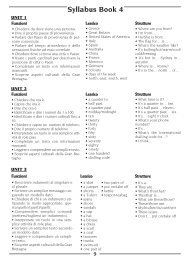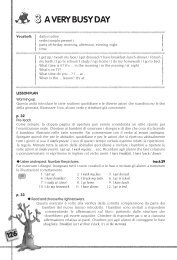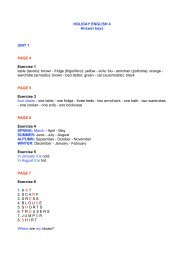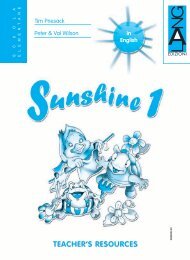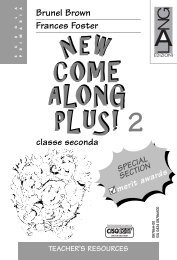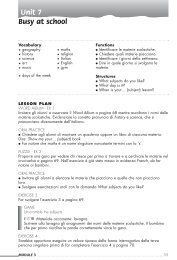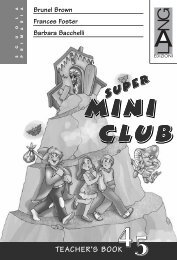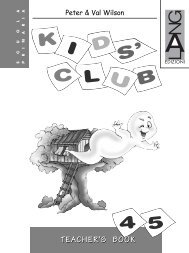You also want an ePaper? Increase the reach of your titles
YUMPU automatically turns print PDFs into web optimized ePapers that Google loves.
LANG EdizioniPBM Editori Spacorso Trapani, 16 - 10139 TorinoFax 011 75021510per informazioni:uffici di Milano, Tel 02 74823207E-mail: info@langedizioni.comhttp://www.langedizioni.comLANGPrimaryINSIDEREWARDSTICKERSDecember 2003Issue SixteenChristmas greetings to all!Another Christmas, another yearcoming to an end. Not only do our childrenseem to look younger every September, thisyear in the first class many of them areactually younger! This is one of the firstvisible changes in Italian Primary schools thisyear as the ‘reform’ of the system starts up.The March 2004 issue of LANG Primarywill include full details of the effects ofthe ‘reform’ on the teaching of English asL2 in schools together with details ofthe new LANG publications to meetthe needs of the new school.Another great year for LANG.It gives the authors and editors ofLANG immense pride to announcethat, for the second year running,more Primary schools adoptedLANG course books than anyother national or internationalpublisher!Our heartfelt thanks to allthose teachers who put theirtrust in LANG publicationsfor the Primary school.This issue of LANG Primaryinevitably includesphotocopiable <strong>worksheet</strong>s onthe theme of the Christmasseason. The reader will alsofind stimulating articles on theteaching of English to children aswell as a repeat set of the RewardStickers that so many teachers haveasked us for.IndexHogmanay – Background and Worksheet p 2Pancake Day – Background p 4Class and teacher projects p 5Christmas – Worksheets p 6Reward Stickers p 8Kids’ Corner p 9Christmas – Background and Worksheet p 13Summer and Winter Sports – Worksheets p 15Valentine’s Day – Background and Worksheets p 171
LANGPrimaryHogmanay - Scottish New YearJoanna CarterBACKGROUNDew Year’s Eve is celebrated all around the world but perhaps the Scots have the lastNword on how to really celebrate it. In Scotland there is a long rich heritage associatedwith this event. There is even a special name for it Hogmanay.Until recently, the 31st of December was considered more important than Christmas inScotland. Many Scottish people had to work over Christmas in the past and so their winterholiday was at New Year when family and friends gathered for a party and exchanged kissesand presents, especially for the children. This occasion came to be known as ‘hogmanay’and the tradition still continues today. In origin it is a much, much older celebration,probably inherited from the Vikings, for whom observing the passing of the shortest day wasimportant.Why is it called Hogmanay?There is a lot of confusion overthe origin of the word hogmanay.Nobody knows the real reasonfor the name, but there are manytheories. Some say it comes froman Anglo Saxon word meaningHoly Month, others that it comesfrom the Gaelic oge maidnewhich means New Morning.There is even a modern dayinterpretation which is that itreally means Hug Many, as it isimportant to embrace and kissfriends and relatives aftermidnight!There are many ancient traditionsthat surround Hogmanay, that takeplace before and after midnight.Before MidnightBefore the bells strike midnight,it’s important to have the housevery clean and tidy and to besure that any rubbish has beentaken outside. Also all debts mustbe settled and nobody must oweanybody money. The idea of thisis that people clear out the oldyear and welcome in the youngNew Year on a happy note.After MidnightImmediately after the bells haverung, it’s traditional for people tocross arms and join hands in alarge circle to sing For Auld LangSyne. This song is now known allover Britain and in other Englishspeaking countries, but it wasoriginally written by Scotland’sgreatest poet Robert Burns, whooften wrote in dialect. For auldlang syne means in memory ofpast times.Should auld acquaintance be forgotAnd never brought to mindShould auld acquaintance be forgotFor the sake of auld lang syne.For auld lang syne, my dear,For auld lang syneWe’ll take a cup of kindness yet,For the sake of auld lang syne.First FootingAfter midnight it is alsotraditional to visit (or first foot)friends’ and neighbours’ houses.People should bring a gift ofwhisky, a lump of coal and something to eat: black bun, oat cakesor a delicious biscuit calledshortbread. Those who stay athome hope that the first over thedoor step or the first foot is a tall,dark and handsome man as thisbrings good luck! Many gifts areexchanged and people offer HetPints – a mix of a special beercalled ale, nutmeg, whisky, sugarand eggs!Recipe for Shortbread150 g plain flour150 g caster sugar100 g butterSieve the flour into a bowl. Addthe sugar. Rub in the butter. Themixture will be crumbly at first –continue until it clings togetherin heavy lumps. Put the mixtureon a lightly floured board.Knead it lightly. Roll it out to a20 cm circle and place on agreased baking tray. Prick overthe top with a fork and flute theedges with your fingers andmark into 8/10 portions. Bakefor 30 to 35 minutes at 170°cuntil cooked but not brown.Leave on the tray to coolslightly. Then lift off with a fishslice or similar and put it on acake rack to cool completely.Fire CeremoniesIn many parts of Scotland, thereare ceremonies with fires,fireworks and torch processionsat Hogmanay. Perhaps the mostspectacular ceremony takes placein Stonehaven, near Aberdeen.Here giant fireballs are lit andswung around on two metre-longLANGPrimarykeeping the teacher informed2
poles. It is a custom linked to thewinter solstice of late Decemberwhere the fireballs signify thepower of the sun.There are many more traditionsfor Hogmanay that differ fromregion to region all overScotland. But one thing can beguaranteed, wherever yougo, people dance, sing,drink and eat and have areally wonderful party!WORKSHEETLook at the written cluesand pictures and completethe crossword. All thewords are about New Yearcelebrations in Scotland.What is the hidden worddown the middle?A ScottishNew YearCelebration1. A strong Scottish drinkthat people have on NewYears Eve.2. You can see these inthe sky.13. At midnightpeople playthis Scottishinstrument.236544. This is the timewhen people kiss,hug and sing.78 H N Y6. At midnight people______ Auld Lang Syne.5. Everybody hopes that atall, ______ stranger willbe first in the house.8. This is what people sayat midnight.‘H –––– NEW Y ––– !’7. People take ______biscuits as presents totheir neighbours.3
PANCAKE DAYJoanna CarterPancake Day takes place in England (and other English speaking countries) onShrove Tuesday which in 2004 is on 24th February. In the past, Shrove Tuesday wastraditionally a day of feasts to use up all the rich foods such as fat, butter, sugar andeggs which people were forbidden to eat in the period of Lent that leads up to Easter.So making pancakes to eat was ideal as they are made up of these ingredients.The pancake ingredients also had a symbolic significance at this time of year.Today people still enjoy eating pancakes on what has now come to be known asPancake Day. They enjoy inventing delicious new fillings to put inside the rolled up pancake as wellas traditional ones such as jam, Nutella®, lemon and sugar and treacle (a very sticky, sweet, toffeesyrup). Everybody also has a go at ‘tossing’ or ‘flipping’ the pancake. That is throwing it in the air fromthe frying pan so that it turns or flips over and lands back down in the frying pan (hopefully!).In some parts of the country there are pancake races where people run through the town withpancakes in frying pans held out in front of them. This tradition started in Oliney in Buckinghamshirein 1445. Legend has it that a woman was late going to church so she ran through the town to getthere on time still wearing her apron and carrying her frying pan!There are many songs and traditional rhymes about pancakes form different parts of the country. Thisone is from Cornwall:Tippety-tippety- tin;Give me a pancake and I’ll come in.Tippety-tippety- toe,give me a pancake and then I’ll go.BACKGROUNDHere are two more ryhmes:Who wants a pankake,sweet and piping hot?Good little Grace looks up and says,‘I’ll take the one on top’Who else wants a pankakefresh off the griddle?Terrible Teresa smiles and says,‘I’ll have the one in the middle’.Shel SiverstienEggs ⇒ CreationFlour ⇒ The food of lifeSalt ⇒ WholesomenessMilk ⇒ PurityMix a pankake,Stir a pankake,Pop in the pan.Fry the pankake,Toss the pankake,Catch it if you can.Christina Rossetti41 Why not have a cross curricular lesson anddevelop English skills, cultural knowledge andmaths skills (weighing and measuring) by makingpancakes in the classroom?Here is a recipe to follow:• 220 g self raising flour• 500 ml milk• 2 eggs• 40 g fat or butter• pinch of saltSieve the flour and salt into a basin and make awell in the centre. Break the eggs and pour intothe well. Gradually beat the eggs and flourtogether, adding the milk little by little until youhave a creamy liquid. Beat the liquid for a fewminutes to aerate it and leave to stand.Heat a frying pan with a bit of butter. Pour inenough batter (liquid) to cover the pan. Cookuntil the top is dry then toss or turn the pancakeon the other side until brown.Fill with lemon juice and sugar or jam, honey,Nutella® etc., roll up and serve.Lesson Plans2 If you can’t cook in the classroom but haveplenty of space, play the following game todevelop motor and social skills.Get the class to make false pancakes from clay orpongo.Divide the class into teams. One half of the teamstands in line at one end of the classroom and therest stand in line at the other end. Each teammember needs a frying pan (you could use paperplates). You need one pancake per team. You thenstart a rely race. The first team member must runto the other end of the class and carefully pass thepancake to the second team member withouttouching it or dropping it. The game continuesuntil every team member has passed the pancake.The first team to finish wins.Pancake Day is really what the English doinstead of Carnival. There are Carnivals inGreat Britain but they happen at differenttimes of the year and for different reasons tothe ones that happen in Italy in March.
LANGPrimary projectsThese photographs were sent to LANG by ateacher in Thiene near Vicenza.The children sent in materials for a Class Projectand proudly wore the LANG T-shirts they receivedto school!We have a limited supply of T-shirts left. Classessubmitting the project in this issue may chooseeither Readers or T-shirts as prizes.TEACHER PROJECT - December 2003 - Issue 16We would like to know how teachers plannedthe Malta project as well as the reactions fromthe children who were involved in the preparationof materials.The information sent to us will be of great helpwhen selecting topics for future project work.We would like teachers to describe how theyorganised the project including information on:• the children’s reaction to the project• difficulties that had to be overcome• how teachers of other subjects were involvedin the project• general organisation of the children’s workand preparation of the materials.When the project is complete, please sign it aswork produced by yourself and send to:LANG Primary, Teacher Project – Issue 16PBM spa, Corso Trapani 16, 10139 TorinoLANG Edizioni will send a copy of DAI (dizionariodi apprendimento della lingua inglese) orFRIENDLY italiano-inglese to all teachers whopresent the project following the instructionsdescribed.CLASS PROJECT - December 2003 - Issue 16The theme for your children to organise as aclass or in smaller groups is:Malta: past – present – future.This project encourages the children to find outabout this beautiful English-speaking island.Lessons of geography, history and English canbe linked to cover all aspects of Malta.When the project is complete, please sign it aswork produced by your class (include thenumber of students who have contributed) andindicate whether you prefer to receive PrimeReaders or LANG T-shirts for the children.Send the materials to:LANG Primary, Class Project – Issue 16PBM spa, Corso Trapani 16, 10139 TorinoPROJECT FORMon page 8The materials should arrive in our offices by15.02.2004.We may publish extracts from some of theprojects in future issues of LANG Primary.All the materials submitted become the property of Paravia Bruno Mondadori Editori and reproduction rights are reserved.5
LANGPrimaryWORKSHEETA Letterfor SantaLook at the pictures and choose the words from the list to complete thisletter to Father Christmas.• horse • cake • milk • baby • game boy • box • football • teddy bear• presents • book • perfume • Christmas tree • scarf • skis • cardsDear Santa Claus,It will be Christmas soon and I want to tell you about all the_______ we would like in my family.Well, I would like a _____ _____ and a _________.My sister would like athe chimney, so how about a_________ but it’s too big to bring down_______ of paints – she is good at art.My brother would like a _______ or some new ________ andmy ________ sister would like a _______ _______For my Mum some _________ would be nice and for Dad a new6_________.I will leave you some __________ and _________ for thereindeer.I must go now and decorate theand write my__________ to my friends.Thank you very much.Lots of love from Ben____________ ____________
WORKSHEETBumperChristmas Crossword2. People send —————at Christmas.4. ————— is a3. We decorate theChristmas —————12Christmas plant.1. One of Santa’s littlehelpers is an —————345. We hear —————on Christmas day.57. We often put a—————— on theChristmas dinnertable.8676. One —————had a red nose.101198. We decorate theChristmas treewith —————9. In England weeat ————for lunch.13121411. We give eachother —————on Christmas day.1510. The 26 th December iscalled ————— dayin England.13. Christmas is in themonth of —————12. Santa puts presentsin a —————14. We put an —————on top of the Christmastree.15. The three kingsfollowed a —————7
LANGPrimaryReward StickersWellIn the March 2002 issue of LANG Primary we included a sheet of rewardstickers and during the past year we have had many requests for extra copiesfrom teachers who have been using them with their children. We have decided to giveaway another sheet to our readers with a reminder that a black and white version of thestickers can be found in Children in Action by Carmen Argondizzo (LANG Edizioni, 2002).They can be photocopied and given to the children who can then colour them.doneReward, or encouragement stickers are very popular with Primary teachers and children in theUnited Kingdom and are used to encourage and motivate children to take that little extra care whenthey are doing class work or homework that requires concentration and precision. The little extracare can be rewarded with a sticker which is put onto the written or visual work.The reward stickers can be used in several ways.••••The teacher can choose the best homework exercise eachweek and give a sticker to the winner.A sticker can be put on a particularly good exercisecompleted during a lesson.The teacher can ask the children to read exercises completedby the class and elect a winner each week.The teacher can use the stickers not only to reward a child whohas completed a language task efficiently, but also to encouragea child who has made a special effort to do well.•The teacher should try to give at least one sticker to every childduring the school year.Beautiful workGoodSplendidImprovingWellBrilliantFantasticdoneBeautiful workGoodSuperstarGreatSplendidimprovementSuperImprovingWellExcellent workGreatBrilliantimprovementFantasticdoneSuperbGreatSuperstarGreathomeworkExcellentimprovementSuperExcellentExcellent workGreatGreatVery goodimprovementImprovingSuperbGreatworkImpressivehomeworkExcellentGood homeworkworkImpressiveWellGreatExcellentGreatVery gooddoneimprovementImprovingExcellentImpressiveGoodGood homeworkworkworkImprovingWell presentedworkImpressiveWellGreatWelldoneVeryimprovementExcellentdonegoodGoodGreat homeworkLovelyworkGreat homeworkworkImprovingWell presentedSuperstarWellGreat homeworkVerydonegoodLovelyworkGreat homeworkSuperstarGreat homework08822P-01The children will be very proud of the stickers they receive and willcertainly show them to their families. Encourage the children to keepthe exercises with reward stickers in their Portfolio Dossiers or aplace where they normally keep special work.GreatimprovementImpressiveworkTHIS FORM MUST ACCOMPANY ALL PROJECTSName of school _______________________________________________________________________________Address ______________________________________ City __________________ CAP ________________Name of teacher _____________________________Code of class _________Number of children involved in the project _____I give permission for LANG Edizioni to send this class project to another school in exchange for theirproject.Write Yes or No _____Signed by the teacher____________________________________________________ Date _______________8See page 5
Kids’CornerBody mattersJohn BattyOne of the most difficult aspectsof teaching English is disciplineand classroom control. Theyhave an important effect on motivation andthe amount of learning that goes on in theclassroom.The most effective learning environment isnormally found in a classroom where a teacher isfirm but kind and encouraging. The teacher shouldbe consistent in his/her way of maintainingdiscipline as children notice inconsistency quickly.Using humiliation or bullying is not advised as itcould result in the inhibition of the students,making teaching a second language more difficult,especially when we consider that we want thechildren to use English freely and actively. Theteacher should set an example so we shouldbehave as we want them to behave.Getting the children’s attention•Hold your hand up in the air, or clap, or blow awhistle. Do not speak until you have theirattention. Then one or two of the children willnotice you and begin to tell their classmates tobe quiet.•Give a series of instructions, i.e. put your pensdown and close your books, or Simon says typeinstructions, for example, touch your mouth andyour ear, good. Now touch your knee and yourhead.•Make eye contact with the noisier children andsay their name in a normal voice or possiblytouch them lightly on the head or shoulder.Maintaining a fairly low noise level•Make silence flashcards with either a picture orthe word silence or both, which can be used bythe teacher. The students can also use them whenthey feel that the noise level is too high.•Don’t shout above the noise of the class; this willjust add to the noise level and also harm yourvoice.•Make eye contact with the noisier students andmake calming down actions with arms andhands.Calming a class down•When planing the lesson, the teacher shouldthink about the rhythm of the lesson and when touse stirring activities and when to use settlingones.•Have a “time out” chair where the students cango and take time out for a couple of minutes orbe sent so that they can calm down or thinkabout why they have misbehaved. While on thischair the students can’t talk to classmates or takepart in the activity.•Play background music. A collection of CDs ofrelaxing music (classical, ethnic, etc.) could bebuilt up and played at a low volume whilestudents are working. This is not only good forrelaxation but also good for concentration.•Use “settling” activities such as Simon says, 1-2-3 Freeze, Dead soldiers, etc.Developing responsible behaviour•The students and teacher make and sign a classcontract.•The students make illustrated classroom ruleswhich can be displayed around the classroomand then referred to when they are broken.Organisation of learning activitiesSometimes the class becomes disruptive and hardto handle as a result of inappropriate tasks that theteacher might have chosen while planning thelesson. Here are some questions that the teachercan ask him/herself to see if the students’disruptiveness is due to the teacher’s lessonplanning.9
LANGPrimary•Were the instructions explained in clear simplelanguage?•Was the activity too difficult or too easy?•Were clear examples and demonstrations given?•Was there too much dead time for the able andslow learners?•Were “filler” activities prepared for thosestudents who finished early?•Did the teacher check understanding of instructionswith concept questions and/or asking an ablestudent to repeat back the instructions in L1?•Were the groups too big?Activity 1: Body mobileWhat you do1. Hand out the strips of paper and getthe children to draw a head, shoulders,knees, toes, an eye, a nose, an ear anda mouth on eight of the strips and to dothe same on the remaining strips.2. The children then colour them.3. Then place the strips face down in theorder of the song “head and shoulders,knees and toes” and put glue on theback.4. Place the string over one row of strips(horizontally) and “sandwich” it withthe corresponding strips (see diagram).5. Hang up in a draughty place.What you need:Sixteen strips of paperStringGlueA pencilColouring pensComments: good follow-up activity for head and shoulders, knees andtoesActivity 2: Song: One finger, one thumbOne finger, one thumb, keep moving.One finger, one thumb, keep moving, one finger, one thumb, keepmoving, and off to town we go.One finger, one thumb, one arm, one leg, keep moving.One finger, one thumb, one arm, one leg, keep moving.One finger, one thumb, one arm, one leg, keep moving, and off totown we go.One finger, one thumb, one arm, one leg, one hand, one foot, keep moving.One finger, one thumb, one arm, one leg, one hand one foot, keep moving.One finger, one thumb, one arm, one leg, one hand one foot, keep moving, and off to town we go.One finger, one thumb, one arm, one leg, one hand, one foot, stand up, sit down, keep moving,One finger, one thumb, one arm, one leg, one hand, one foot, stand up, sit down, keep moving,One finger, one thumb, one arm, one leg, one hand, one foot, stand up, sit down, keep moving, andoff to town we go…Comments: This song gets faster and faster10
Activity 3: Body and Clothes TwisterWhat you do1. Enlarge and photocopythe flashcards onto sheets ofA4.2. Create a space for eachWhat you need:Flashcards of clothesand body parts on sizeA4 card or paper (1 setper 3-4 students)A large spacegroup of 3-4 students. Hand out the sets of cardsand tell the students to place the cards strategicallyon the floor.3. Give each student a number within their group.4. Give “twister” instructions, e.g. number one, putyour right hand on the nose. Good. Now put yourleft foot on the body. Number two, put……., etc.5. Give instructions that are possible, but difficult toachieve. If they remove a part of the body from aflashcard or they fall down, they are eliminated.6. The student who completes all the instructionswins.Activity 4: Body board gameWhat you do1. Photocopy the board game onto card and coverwith plastic.2. Hand out 1 board, 1 dice, 4 counter, 4 pencilsand 4 pieces of paper to each group of 4 students.3. Tell the students that the objective of the game isto complete a drawing of a person that iscompletely dressed.4. First they have to complete the body with all itsparts before going on to dress it.5. The first child throws the dice and says forexample, two – body and then draws the body andthe next student throws the dice.What you need:1 enlarged photocopyof board game per4 students1 piece of paper anda pencil per student1 dice per group1 counter per student6. If they land on abody part or a piece ofclothing that theyalready have, they missa turn.7. If they do not say thenumber, the body partor the piece of clothingthey also miss a turn.11
LANGPrimaryActivity 5: Clothes line dictation relay raceWhat you do1. Divide the children into two or four groups.2. Ask two of the children to take a piece of stringand hold it up as if they were the “washing line”.3. The teacher then calls out the names of theclothes.4. The children in turn run, pick up the piece ofclothing that they think they hear and hang it onthe line.5. When the teacher has finished calling out theclothes, the race stops and then the washing lineis checked. The team that hangs out the correctwashing in the correct order wins.What you need:StringClothes pegsOld clothesWashing bowl (if possible)Activity 6: Body and clothes pelmanismWhat you do1. Students make simple flashcards for each of the body parts and clothes.2. Students make a similar set of corresponding word cards.3. When the students have finished the cards they shuffle them and thenplace them face down on the table. Within their groups the students then inturn take two cards at a time, trying to find a matching pair, i.e. the wordbody with the picture of a body.4. If a student finds a pair he/she continues until he/she doesn’t find a pair.5. The student with the most pairs at the end of the game wins.What you need:CardPencilsColouring pens/crayonsscissors(one set of clothes andbody picture cards pergroup of 4-5 students)Activity 7: Class robotWhat you do1. Tell the students they are going tomake a robot.2. Put the children into groups of 6-8and give each group one large sheetof paper.3. Give them some glue and a box ofcollected materials.4. Tell the students they can stick thematerials anywhere they like.5. When they have finished tell thestudents to give their robots a nameand hang it on the wall.What you need:1 large sheet of paper witha robot sketched on pergroup of 6- 8 students(see illustration)Silver paper/ foilSweet and chocolatewrappersYoghurt cartonsBottle topsGlue12
Christmas DinnerJoanna CarterBACKGROUNDAs in many countries, Christmas dinner is very important in England. The mainmeal is usually eaten at lunchtime or early afternoon on 25th December.In the past, people ate roast sirloin of beef but nowadays a typical dinner consists of roast turkey or goose,served up with stuffing, bread sauce, cranberry sauce and gravy. Stuffing is put inside the turkey and ismade of bread crumbs, sausage meat, onion and herbs and spices. Bread sauce is a white sauce to pourover the turkey with bread crumbs, cloves, nutmeg and cream in it. Gravy is simply the ‘juices’ that comeout of the meat while it’s cooking and cranberry sauce is like sour jam made from….. cranberries!Many vegetables accompany the meat such as peas, carrots, beans, cauliflower, Brussel sprouts, roastpotatoes and parsnips. Parsnips are vegetables that look like big yellow carrots but tastemore like potatoes.Some people have Yorkshire pudding with their Christmas dinner. This is alsotraditionally eaten with roast beef and is a type of savoury cooked batter.If you are still hungry after all that, Christmas pudding and mince pies follow the maincourse. Christmas pudding, otherwise known as plum pudding, or figgy puddingdates back hundreds of years in Great Britain. It is a rich mix of dried fruits such asraisins and figs, nuts, flour and brandy and is round and dark brown when cooked.The pudding is usually made some weeks before the festive period and all the members of the familyshould stir the mixture with a wooden spoon and make a wish. It is then steamed and served with flamingbrandy on Christmas day. Traditionally silver coins were hidden in it. This brought good fortune towhoever was lucky enough to find one in their portion when the pudding was cut.No dinner table is complete at Christmas without Christmas Crackers. These are brightly coloured papertubes closed at both ends. There is a banger inside and two people must take either end and pull thecracker open. Inside you can find a funny paper hat, a joke and a very small gift. This custom of pullingcrackers came to Britain in the 1860’s and is still very popular today.Find out how to make a Christmas Cracker on page 14. It may be too difficult for the children tofind or write jokes in English so ask them to write a forfeit in English instead. For example, ‘Countto ten in English’, ‘Say the English alphabet’. Obviously the crackers won’t have a banger inthem either, so ask the children to exchange them as gifts in class and carry out the forfeits.The jokes in crackers are often based on a play on words and are usually terrible!!Here are some examples:•How does Father Christmas climbup a chimney?He uses a ladder in stocking!•What do vampires put on their turkey atChristmas?Grave-y!•What flower can you eat?A cauli-flower!•This turkey tastes like an old sofa!Well, you asked for something with plenty ofstuffing!•Did you hear about the stupid turkey?It was looking forward to Christmas!•What’s the best thing to put into a Christmascake?Your teeth!Recipe for Yorkshire Pudding (serves 4)You need:A roasting tin 28 x 18cms75g plain flour1 egg75ml milk50ml watersalt/pepper2 tablespoons beef dripping (dripping is fat soif unavailable could be substituted with oil)Sift the flour into a bowl. Make a hole in thecentre and break the egg into it. Mix into theflour and gradually add the milk, water, saltand pepper. Mix until smooth. Heat the fat/oilin the tin at 220°c. Carefully pour in the battermix when the fat is sizzling. Cook on thehighest shelf of the oven for 25-30 minutes.The pudding should have risen and be crisp andgolden. Serve as soon as possible with meat. 13
LANGPrimaryWORKSHEETCHRISTMASdinnerCOTOPABE S1UR2 P O L SS T U RLRA SL S IART4 S F UCE P 5 E3A6T E Y K UE B N RA SEOR T9S C A SA B N S7EPP IB8G AOWR1. B __________2. C __________3. P __________4. P __________5. C __________6. B __________7. C __________8. P __________9. T __________In England people have a lot of things on one plate for Christmas dinner! Put the words in order and findout what they eat. CLUE: ALL the words are winter vegetables except for ONE – What is it? ............................MAKE A CHRISTMAS Cracker! (see article on page 13 andphotograph on page 17)1 Put a tissue paper hatand a sweet inside thecardboard tube.2 Roll the tissuepaper around thetube.You need:A cardboard tube (15cm long)Coloured tissue paperRibbon (30cm long)GlueScissors3Glue the edges togetherand tie a piece ofribbon around each end.Decorate the outside.14
WORKSHEETSports all theyear roundIn the summer, Jane likes playing tennis and going swimming. In the winter, she likes going skiing.All the things she needs for these sports have got mixed up in her wardrobe. Can you help her tidy up?Look at the picture and write the words in the correct column.For skiing Jane needs:1. ............................................................2. ............................................................3. ............................................................4. ............................................................For tennis Jane needs:1. ............................................................2. ............................................................3. ............................................................4. ............................................................For swimming Jane needs:1. ............................................................2. ............................................................3. ............................................................4. ............................................................GLOVESTOWELGOGGLESSCARFSKISSWIMMINGCOSTUMETENNIS RACKETBOOTSTENNIS SHOESTENNIS BALLHere are some more sports. Which do we play more often in the summer, in the winter, all year round?• skating • basketball • ice hockey• golf • baseball • karate• beach volleyball • jogging• football • table tennis• surfing• horse ridingsummerALL YEARwinter15
LANGPrimaryWORKSHEETMORESPORTSPhotocopy these sets of cards, cut them up and give a set of words and pictures to small groups ofchildren. They spread them out face down and mixed up on the table. They then take it in turns toturn two over. If the picture and the word match they keep the two cards. If not, they turn them facedown again. The person with the most matching pairs wins.• Make the pictures into flashcards beforehand to pre-teach the vocabulary.• Children can gain extra points by saying the right verb (play/go/do) with the sports pairs they win.skatingskiingballettennisfootballbasketballjudohorse ridingGuess which sports action the snowman is doing and complete the sentences.kickingthrowingjumpingrunningswimmingcatchingHe is ____________ the footballHe is ____________ in the seaHe is ____________ very fastHe is ____________ in the airHe is ____________ the basketballHe is ____________ the javelin16
VALENTINE’S DAYJoanna CarterDid you know?Valentine’s Day has its origins in an ancient Roman feast called Lubercalia,held on 15th February. On the eve of the feast young women, would put theirnames on slips of paper and put them in a jar. The young men would pick out aname at random and the pair would then be partners for the rest of the feast.BACKGROUNDThere are different legends that explain how Saint Valentine became associated with the rite. One saysthat Valentine was a priest in ancient Rome. The Emperor Claudius II outlawed marriage for young menso that they would become soldiers. But Valentine defied the Emperor and continued to marry younglovers in secret.On February 14th he was put to death for his “crime” and so became patron saint of lovers. Anotherlegend says that Valentine sent the first “Valentine” greeting himself. He fell in love with the jailor’sdaughter while in prison and before his death wrote her a letter signed “From your Valentine”. This isan expression that is still used today.SOME VALENTINE TRADITIONSIn the Middle Ages, peoplebelieved that birds chosetheir mate each year onFebruary 14th.If you cut an apple in halfand count the seeds, thiswill tell you how manychildren you will have.In the past, men and women drew namesfrom a bowl to see who their Valentineswould be. They wore the names on theirsleeves for a week. Today we still use theexpression “to wear your heart on yoursleeve” about people who show theiremotions easily.See on page 14.If you see a robin fly overhead,you’ll marry a sailor. If you see asparrow, you’ll marry a poor manbut be happy. If you see agoldfinch, you’ll marry amillionaire!In Wales, wooden love spoonswere given as gifts on February14th. Hearts, keys and key-holeswere also popular decorations, themeaning being “you unlock myheart”.See on page 18.17
WORKSHEETVALENTINE CardIn England and America, it’s traditional to send a card to the person you love on February 14th. You usuallysend it as a secret admirer and don’t sign your name.1 Copy the templateonto red card. Cut outand fold in the 2sides.FOLD IN2 Decorate the frontwith hearts andflowers like the onein the photograph.3 Inside write apoem or message.Send the card to aperson you like inyour class, your mumand dad or yourteacher. Remember,don’t sign your name!Popular Messages:• Roses are red, violets are blue,sugar is sweet and so are you.FOLD IN• From your Valentine.• The birds won’t sing,the sun won’t shine,if you won’t be my Valentine.See photograph on page 18.18
WORKSHEETVALENTINE poemsWhen girls and boys send cards to each other on St Valentine’s day, they often write a poem inside to sayhow much they like the other person.Complete these poems with the words from the box. Remember the word must rhyme with the name inthe poem.• dizzy • smart • sad • brain • cosy • marry• sweet • fairer • me • pretty • jolly • greatDo you likeme Kitty?I think youare really____________To my darling,handsome Pete.I think you arereally___________To a boy I knowcalled BradIf you won’t bemine, I’ll bereally__________I like a boywho’s handsomeand ____________Have you guessed?His nameis BartMy Valentine is funand ____________A smile sosweet, her nameis HollyBe my Valentinedear Rosie.You make my heartfeel warm and____________I love a fabulousgirl called JaneI just can’t get herout of my____________The one I love,his name isBarryHe’s the oneI want to____________Will you be mygirlfriend Lizzy?When you smile,you make me____________To a beautiful girlcalled Sarah.In my worldthere’s no one____________In my classthere’s a boycalled Lee.How I wish hebelonged to_________To my darlingKateI think you’rereally____________19
What’s New from LANG?The LANG web site continues to grow and an increasingnumber of teachers are visiting and downloading the materialswe have put on-line.Our web site at www.langedizioni.com now includes:• supplementary teaching materials linked to specific coursebooks including teacher’s guides in English• an exciting new e-learning programme for teacherdevelopment designed for teachers who use the newEuropean Language Portfolio - Junior• Worksheets and songs divided by festivities.To assist teachers who seek extra teaching materials on thethemes of the various festivities celebrated in Great Britain andthe United States of America, we have opened a new page onthe LANG web site.In the section scuola elementare of the home page, thiscollection can be reached by clicking on the word festivities.Listed under the names of the festivities, teachers will find listsof both <strong>worksheet</strong>s and songs that can be downloaded for usein class.The DEMO of the new series of interactive CD ROMsWILLY WIZ PRIMARY ENGLISH is being distributed.If you would like to try out this programme in your interactivelaboratory, ask your local agent for a copy.The Primary Notice Board at http://langprimary.omnilog.infocan be visited at any time to leave messages for other teachersor to communicate with the editors at LANG.IMPORTANT NOTICEAs from 2004, LANG Primary will be publishedthree times a year in March, October and December.Contributors to this issue:John BattyJoanna CarterTim PriesackEditorTim PriesackAssistant editorsBarbara BacchelliImmacolata MarsagliaLayout and GraphicsGraphic Center, TorinoQuality ControllerLuca FedericoIllustrationsFabiola ZardoniPhotographic sourcesArchivio Paravia Bruno MondadoriEditoriPrintedGrafiche Mek, Milano08822P-00Teachers wishing to receive LANG Primary can registersubscriptions either on-line at www.langedizioni.com or byusing the coupon below.Future issues of LANG Primary will be posted to homeaddresses.CERTIFICAZIONE DI QUALITÀUNI EN ISO 900116NameHome addresse-mailSchool name and addressNew subscription ❏CityCityChange of address ❏CAPCAPCourse book usedThis is the first issue of LANG Primary I have read Yes ❏ No ❏I would like a LANG agent to visit me at school Yes ❏ No ❏Ai sensi della Legge 675/96, con la presente vi autorizzo esplicitamente al trattamento dei miei datipersonali unicamente ai fini amministrativi per l’invio di materiali di Lang Edizioni al mio indirizzo.20 Post or fax to: PBM Editori spa - LANG Primary – Corso Trapani 16 – 10139 Torino – Fax 011 75021 510



